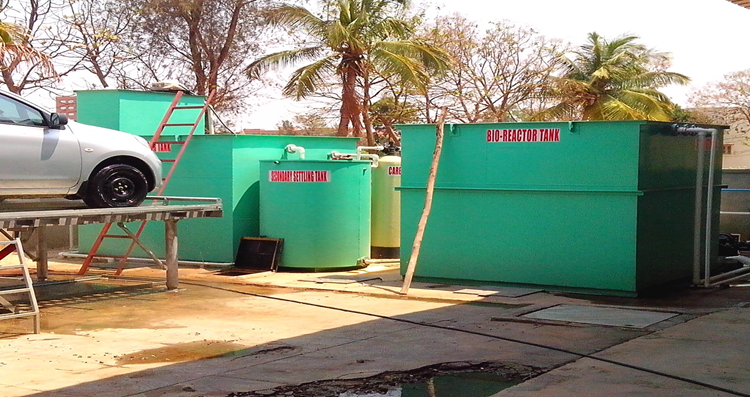Waste Water Treatment Plants
We set up and maintain Waste Water Treatment Plants
Waste Water Treatment Plants
Wastewater treatment is a process used to remove contaminants from wastewater or sewage and convert it into an effluent that can be returned to the water cycle with minimum impact on the environment, or directly reused. The latter is called water reclamation because treated wastewater can then be used for other purposes. The treatment process takes place in a wastewater treatment plant (WWTP), often referred to as a Water Resource Recovery Facility (WRRF) or a sewage treatment plant. Pollutants in municipal wastewater (households and small industries) are removed or broken down.

Effluent Treatment Plant
The effluent in municipalities and industries contain several disease-causing organisms called Pathogens. It also brings with it inorganic substances in dissolved form to the treatment plants. Some of the inorganic substances commonly found in wastewater are Sulphur, Nitrogen, Phosphorous, and Hydrogen Ions which have the potential to change the pH of water. It also contains chloride and compounds that can increase the alkalinity of the wastewater.
Phosphorous and Nitrogen are useful to plants as nutrients. But if large amounts of treated wastewater containing these elements are discharged into water bodies, it will lead to the growth of alga in those water bodies.
Apart from removing inorganic substances you also have to consider the dangers posed by toxic compounds. The treatment plant should also be able to handle the heavy metals in the waste.
The design of the treatment plant has to incorporate and satisfy strict pre-treatment criteria so as to protect the downstream treatment process from toxic shock.
The biological treatment process utilizes microorganisms to treat the wastewater. This step of treatment generates a large measure of gases like Carbon Dioxide, Methane, Ammonia, Hydrogen Sulphide and Nitrogen.
The nature of dissolved gases in the treated wastewater can be analysed to identify whether an Aerophilictreatment process(involving organisms that require oxygen to survive) is underway or ifAnaerobiotic microorganisms (organism sustaining in the absence of oxygen) is active.
Biological treatment processes normally involve the action of aerophilic microorganisms. For this process to run smoothly, wastewater should have a sufficient measure of dissolved oxygen. Hence the design of the plant should also incorporate wastewater aeration.
If the analysis of the treated effluent indicates the presence of gases like Methane and Hydrogen Sulphide, then that is an indication of an anaerobic process underway during biological treatment. The
by-products of such an anaerobic process will have a bad odour. This can be due to improper design of the plant or sometimes this could also be the result of a particular anaerobic process used in the treatment process.
Desolvation
Desolvation is the process wherein an aqueous solution the water molecules that were once in between the substrate and the enzyme are moved to allow the interaction of the substrate with the enzyme. The process makes the formation of the enzyme-substrate complex more thermodynamically favourable and increases the number of specific ways it can be arranged.
The method of desolvation involves drying a sample in a solution. For instance, in an aqueous solution electro-statically bound particles are made to separate by releasing water. This method is common in atomic absorption spectroscopy, in which an atomic gas is produced through a liquid sample. It can also be used in vaporization.
Solvation Process of a “Salt” in water:
The process of a salt dissolving in water is called the solvation process and is defined as the solubility of salt in water.
The EN difference between H ─ O in a water molecule forms a dipole.
The H is δ+ and the O is δ─. Since a salt crystal has opposite charges due to its ions, the H δ+ end is attracted to the anions (Cl1─) in the salt. Several H’s surround the anion and neutralizes the ionic bond between the Na1+ and Cl1─. As a result, the ions can be “plucked” off one at a time and float around independently in solution. The opposite occurs between the Oδ─ and the Na+ ions until they are plucked off and floating around independently.
Independent ions will float around only if the attractions between the individual ions (salt) and the partial charges on the water molecule are stronger than the ionic bonds themselves.

Coordination Number - the number of oppositely charged neighbours a central atom has. NaCl each has a coordination number of 6.

Source: http://nanotech.sc.mahidol.ac.th/genchem/solid1/salt.jpg